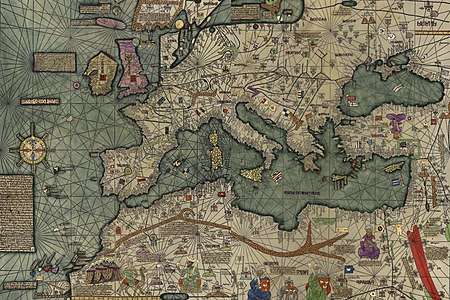Catalan chart
Catalan charts, Catalan maps or Catalan portolans are a subtype of the medieval period (1300–1500) portolan chart. Portolan charts are a type of map generated by using a mariner's compass and direct observation to determine the shape and location of coastlines and ports. The term "portolan" means "pertaining to ports and harbors" and should not be confused with "relating to Portugal". Sometimes they are referred to as "Catalan type" portolans or simply Catalan portolans.[1] Two primary subgroups of medieval period portolan maps exist, the Italian, and the Catalan. While both the Italian and Catalan maps derive from the same common source (readings from a compass combined with direct observation), there are several differences, both in terms of style and in content.
Similarities between Italian and Catalan Portolans

Portolan and Catalan maps all share the characteristic windrose networks, which emanate out from compass roses located at various points on the map. These better called windrose lines, are generated by observation and the compass, and designated lines of bearing (though not to be confused with modern rhumb lines, meridians or isoazimuthals).
Portolan and Catalan maps are also characterized by the accuracy of inland features, sometimes for the lines of latitude/longitude and specially for the lack of map projection,[2] for cartometric investigation has revealed that no projection was used in portolans. To understand that the straight lines drawn on the map should be better called "windrose lines", one has to know that they can be loxodromes (modern rhumblines) only if the chart was is on a suitable projection.[2]
As leo Bagrow states:"..the word ("Rhumbline") is wrongly applied to the sea-charts of this period, since a loxodrome gives an accurate course only when the chart is drawn on a suitable projection. Cartometric investigation has revealed that no projection was used in the early charts, for which we therefore retain the name 'portolan'."[2]
Differences between Italian and Catalan Portolans
Scope
The Catalan type portolans have a larger scope than the Italian maps, which generally covered the Mediterranean region and western Europe. In contrast, the Catalan type portolans extended as far north as Scandinavia and occasionally as far east as China.
Content
While both maps primarily serve as navigation tools, showing the relationship between a point at sea and various harbors/coastlines, the two differ in terms of additional content. The Italian type portolan only shows coast lines, harbors and the open sea, whereas the Catalan type map also shows other information:[3]
- Inland seas are shaded differently than external seas
- Seas are named
- Directions on the compass rose.
Additionally, there are examples of Catalan maps which show other details, such as roads or inland cities. One such example is the Catalan Atlas, one of the most important examples of Catalan work.
Evolution
In general, the overall "Italian" style of portolan map ceased its evolution towards the end of the 13th century, whereas the medieval Catalan map continued to evolve. There are, however, some difficulties in assessing this statement completely, as there are several Italian maps which show significant influence from the Catalan style map.
Catalan maps milestones
Major Catalan maps in history
Sites of Major Catalan Schools
Major Figures in the Development of Catalan Maps
See also
References
- Maps and their Makers, J.C.C Crone, Hutchinson & Co, London, W.I (1964)
- Leo Bagrow (2010). History of Cartography. Transaction Publishers. pp. 65–. ISBN 978-1-4128-2518-4.
- History of Cartography, Second Edition, Bagrow and Skelton, Transaction Books, New Brunswick (US) (1985)